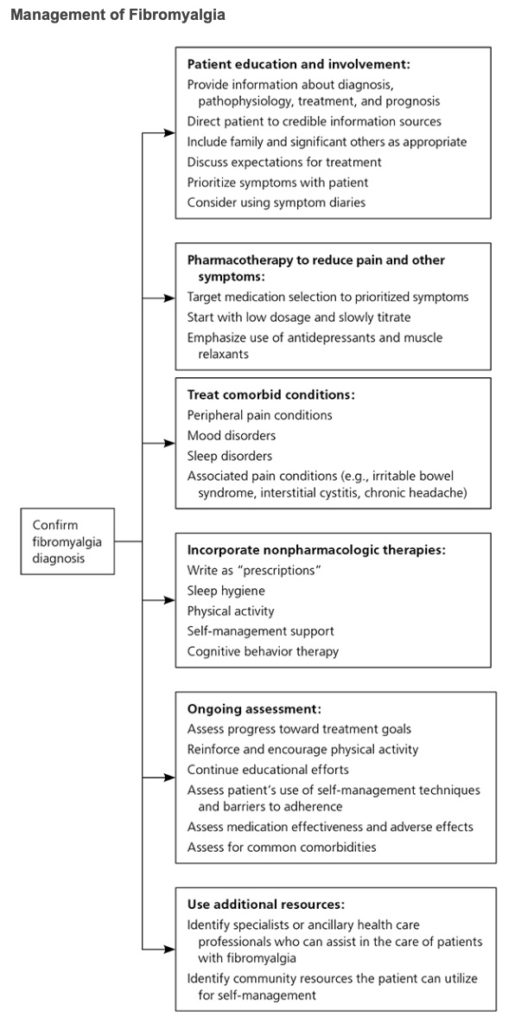Fibromyalgia Treatment Options
If you have been diagnosed with Fibromyalgia you probably already know there is no cure.
Treating Fibromyalgia symptoms is the course of action. Favorable results requires a team approach. Your patience and willingness to follow your Doctor’s prescribed treatment options in combination with a motivated Doctor willing to trial options to determine what strategies work best for you is critical.
It will be helpful to revisit the extensive list of Fibromyalgia symptoms (source; healthline):
- fatigue
- lack of energy
- trouble sleeping
- depression or anxiety
- memory problems and trouble concentrating (sometimes called “fibro fog”)
- headaches
- muscle twitches or cramps
- numbness or tingling in the hands and feet
- itching, burning, and other skin problems
- diarrhea and/or constipation
- belly pain
- bloating
- gas
- nausea
- excess sweating
- easy bruising
- swelling
- sensitivity to noise, light, or temperature
- jaw pain
- chest pain
- bladder pain
- an urgent need to urinate
- food allergy symptoms like a stuffed nose, wheezing, diarrhea, or vomiting
Fibromyalgia pain can be in the:
- neck
- middle and lower back
- arms
- legs
- shoulders
- hips
Fibromyalgia pain has been described as:
- throbbing
- aching
- burning
- shooting
- stabbing
- soreness
- stiffness
Here’s a quick overview outlining the management of Fibromyalgia:

It’s universally accepted that Fibromyalgia’s root cause is due to a chemical imbalance of neurotransmitters within the brain. Anti-depressants are among the medications used because they are designed to return our brain chemistry back to equilibrium.
Fibromyalgia Medication:
Three drugs are approved by the U.S. Food and Drug Administration for treating fibromyalgia:
- duloxetine (Cymbalta)
- milnacipran (Savella)
- pregabalin (Lyrica)
Cymbalta and Savella are antidepressants. They work by altering levels of chemicals in the brain and spinal cord that control the transmission of pain signals.
Lyrica is an antiseizure drug. It stops the nerve cells involved in pain signaling from becoming overactive.
Other types of antidepressants and antiseizure drugs may also be effective in treating fibromyalgia.
Acetaminophen (Tylenol) and other pain relievers can help with short-term discomfort. Nonsteroidal anti-inflammatory drugs (NSAIDs) such as ibuprofen (Advil, Motrin) or naproxen (Aleve) aren’t effective because fibromyalgia doesn’t cause inflammation.
Exercise:
It has been proven and is well documented that even “mild” exercise helps to maintain healthy brain chemistry in addition to it’s obvious health benefits to our muscles, bones, heart, etc.
Try to exercise as much and as often as you can. Although it might hurt at first, if you stick with a program of aerobic fitness (like walking or bike riding) and toning exercises, you’ll eventually strengthen your muscles and reduce pain.
Prior to initiating any exercise plan, be sure to get an OK from your doctor. If you don’t know how to start an exercise effort, seek physical therapy assistance from a licensed/degreed Physical Therapist.
Sleep:
Sleep can be challenging when one has Fibromyalgia. Lack of sleep can make you feel worse. If you’re struggling to fall asleep or to stay asleep all night, try limiting or avoiding caffeine and other stimulants before bed. Try to go to sleep and wake up at the same times each day to get your body into a rhythm.
Discuss any sleep concerns with your doctor as other sleep therapies exist.
Other Fibromyalgia Treatment and Helpful Strategies include:
- relaxation therapies
- cognitive behavioral therapy (CBT)
- biofeedback
- yoga and tai chi
- acupuncture
- pool therapy
- dry needling
- anti-inflammatory diet
The American Family Physician has some excellent additional Fibromyalgia details. Click on their direct link below:
It’s likely your doctor will introduce a multidisciplinary approach that will include a number of the above strategies along with others.
It will be helpful to keep a journal to record your Fibromyalgia treatment activities while keeping notes on how you feel physically and psychologically. Sharing these details with your doctor will help to insure some positive outcomes/results.
© 2011 MyPainWeb.com. All rights reserved. Privacy Policy
